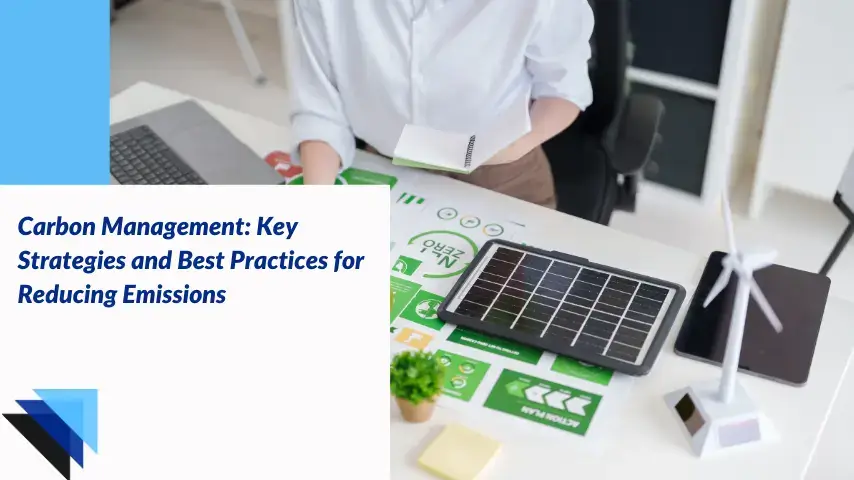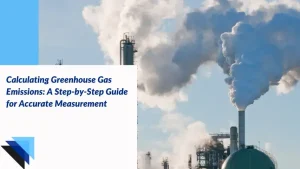Carbon Management refers to the strategic process of measuring, monitoring, reducing, and offsetting carbon emissions to mitigate the impact of climate change. It involves a combination of practices, technologies, and policies aimed at minimizing the release of carbon dioxide (CO2) and other greenhouse gases (GHGs) into the atmosphere.
The escalating consequences of climate change (ranging from rising sea levels and extreme weather events to irreversible biodiversity loss) have brought carbon management and greenhouse gas emissions reduction to the forefront of global sustainability efforts. Environmental legislation, international treaties like the Paris Agreement, and mounting stakeholder demands all drive public and private sectors to actively measure and lower their carbon footprint.
The comprehensive implementation of carbon management is vital for regulatory compliance, Net Zero Carbon Emissions, and advancing environmental sustainability. This guide examines the essential elements of carbon management such as carbon accounting, emission reduction, carbon offsets, and carbon capture technology while highlighting proven approaches and emerging best practices. Whether you’re an environmental manager, policy developer, or business leader, this resource will assist you in translating climate ambitions into impactful and measurable outcomes.
Looking to Take Control of Your Carbon Footprint Early On?
Start your sustainability journey with a structured, organization-wide carbon management approach.
What is Carbon Management?
Carbon Management refers to the strategic process of measuring, reducing, capturing, utilizing, and offsetting carbon dioxide and related greenhouse gases across industries, households, and ecosystems. Central to achieving net zero emissions, carbon management integrates efforts such as Life Cycle Assessment, carbon accounting, GHG Protocol alignment, and the use of carbon calculators to deliver sustainable growth and deep decarbonization.
Why Is Carbon Management Critical in Addressing Climate Change?
The Intergovernmental Panel on Climate Change (IPCC) underscores the urgency of maintaining global temperature rise within 1.5°C above pre-industrial levels to avoid irreversible climate impacts. Carbon dioxide is the leading greenhouse gas, accounts for ~75–76% of global GHG emissions (IPCC; 2010–2019 range), followed closely by other greenhouse gases like methane and nitrous oxide. Physical decarbonization, carbon capture, and emission reduction strategies are key to achieving net-zero goals and meeting domestic policies, stakeholder demands, and ESG regulations.
What Are the Primary Components of Carbon Management?
Efficient carbon management frameworks typically include:
- Measurement and Monitoring – Using carbon accounting software and tools aligned with ISO 14064 standards and the Greenhouse Gas Protocol, organizations track Scope 1 (direct), Scope 2 (indirect energy), and Scope 3 (other indirect) emissions to quantify their carbon footprint.
- Reduction Efforts – Implementation of energy efficiency, electrification, sustainable growth strategies, low- and zero-emissions fuels, and renewable energy credits (RECs), along with direct air capture and industrial efforts like deep decarbonization.
- Offsetting Programs – Investments in carbon offsets, carbon credit purchases, reforestation initiatives, and participation in environmental markets, including both natural carbon sinks and technological carbon sequestration.
Struggling to Track Scope 1, 2, or 3 Emissions Accurately?
Implement ISO-compliant carbon accounting tools to measure your full carbon footprint.
What Are Proven Strategies for Effective Carbon Management?
Implementing effective carbon management strategies demands a mix of advanced technologies, behavioral changes, and policy-driven action. Below are evidence-based methods that deliver measurable reductions in greenhouse gas emissions and advance environmental sustainability.
1. Enhancing Energy Efficiency
Energy efficiency is one of the most cost-effective ways to reduce carbon emissions and fossil fuels dependency. Upgrading processes in industrial, residential, and commercial settings achieves substantial emission reduction while supporting regulatory compliance.
- Industrial Optimization: Deployment of carbon management software, smart automation, and predictive analytics reduces greenhouse gas emissions and cuts waste.
- Residential Initiatives: Life cycle analysis informs the installation of energy-efficient appliances and improved building insulation, enhancing long-term sustainable business practices.
2. Transition to Renewable Energy Sources
Transitioning from fossil fuels to renewable energy sources like solar, wind, and hydro is crucial for decarbonization and achieving net zero emissions.
- Global Impact: The International Renewable Energy Agency (IRENA)’s 1.5°C scenario projects over 90% of global electricity from renewables by 2050, with solar and wind as the main contributors.
- Corporate Leadership: Businesses investing in Renewable Energy Credits and Solar + Storage Microgrids reduce Scope 2 emissions while bolstering sustainability reports for ESG compliance.
3. Implementing Carbon Pricing and Offsetting Mechanisms
Carbon pricing through carbon taxes or emissions trading systems creates market signals for emission reduction. Integrated carbon offsetting, backed by credible standards and environmental markets, provides short-term solutions while companies pursue long-term abatement.
- Case Study: The European Union’s Emissions Trading Scheme allocates carbon credits and regulates greenhouse gas emissions for participating industries, incentivizing deep decarbonization and compliance with international treaties.
4. Investing in Carbon Capture, Utilization, and Storage
Carbon Capture, Utilization, and Storage (CCUS) represent the next frontier in carbon management technology. These processes capture carbon dioxide from industrial sources, power plants, or even direct air capture facilities, then transport and store it in suitable geological formations—CO2 storage sites below ground—to prevent atmospheric release.
- Technological Advances: Carbon capture facilities and carbon management technologies enable both permanent storage and reuse of captured CO2 in industrial processes.
- Future Potential: Innovations such as direct air capture and carbon dioxide removal (CDR) at scale are vital for offsetting hard-to-abate emissions and achieving Net Zero Carbon Emissions.
5. Life Cycle Assessment and Emission Inventories
Life Cycle Assessment (LCA) provides a comprehensive, quantitative analysis of a product’s or service’s environmental impacts across its entire lifespan — from raw material extraction through production, distribution, use, and end-of-life treatment. By applying internationally recognized standards such as ISO 14040/14044 (and ISO 14067 for product carbon footprints), organizations gain reliable insights into the full scope of their environmental footprint.
Complementing this, robust emission inventories at the organizational level — aligned with the GHG Protocol and ISO 14064-1 — ensure accurate tracking of Scope 1, 2, and 3 emissions. Together, LCA and emission inventories form a solid foundation for informed decision-making, compliance with regulations, and the effective deployment of carbon management software.
What Are the Main Challenges and Barriers in Carbon Management?
Implementing carbon management and advancing sustainable business practices involves overcoming numerous challenges: financial, regulatory, and technological.
1. Economic Barriers
Large-scale projects, from renewable energy to carbon capture technology, often entail significant upfront expenditures and regulatory risk. Smaller companies and developing economies may face resource constraints when adopting these strategies or participating in voluntary carbon markets.
2. Policy and Regulatory Gaps
Disjointed domestic policies and inconsistent environmental legislation create uncertainty for organizations trying to achieve net-zero goals. Gaps in policy implementation hamper stakeholder collaboration, while evolving ESG regulations and market requirements increase regulatory compliance complexity.
3. Technological Hurdles
Emerging carbon management technologies such as advanced CCS, direct air capture, and next-generation carbon calculators require continued R&D investment. Energy infrastructures, especially in regions reliant on fossil fuels, present unique integration challenges for renewable energy and deep decarbonization efforts.
Also read: Calculating Greenhouse Gas Emissions: A Step-by-Step Guide for Accurate Measurement
What Are the Emerging Opportunities in Carbon Management?
Despite these barriers, innovation and collaboration continue to unlock opportunities in carbon management.
1. Digital Carbon Accounting & Management Software
The rise of digital carbon accounting and advanced carbon management software leveraging AI and IoT enhances the accuracy and efficiency of greenhouse gas emissions tracking. Enterprises can automate Scope 1, Scope 2, and Scope 3 emissions reporting, support regulatory compliance, and streamline sustainability reports.
2. Growth in Carbon Offset and Credits Markets
Environmental markets for carbon offsets, carbon credit trading, and reforestation initiatives provide valuable emission reduction pathways. Participation in verified carbon projects contributes to net-zero carbon emissions and can generate additional financial value for organizations operating in regulated and voluntary systems alike.
3. Collaboration and Standardization
Engagement in multilateral partnerships, such as the Race to Zero initiative and broad adoption of GHG Protocol and ISO 14064 standards, enables companies to access best practices, improve life cycle analysis, and standardize efforts toward sustainable growth. Knowledge sharing and alignment with net zero targets foster resilient, sustainable business strategies.
Is Your Team Trained to Meet Net-Zero Goals?
Equip your workforce with the skills to implement carbon strategies and ensure compliance.
How Wellkinetics Can Help
Wellkinetics stands at the forefront of environmental sustainability, offering a suite of expert solutions for comprehensive carbon management.
1. Customized Carbon Management Frameworks
Wellkinetics develops bespoke carbon management strategies tailored to client needs. This includes carbon footprint audits, carbon calculator deployment, Scope 3 emissions analysis, and implementation of deep decarbonization pathways—all while integrating the latest carbon management software and regulatory compliance requirements.
2. Workforce Training and Empowerment
By providing education in Life Cycle Assessment, GHG Protocol, regulatory frameworks, and sustainable business practices, Wellkinetics equips organizations to lead and sustain progress toward Net Zero Carbon Emissions and broader ESG goals.
3. Climate Risk and Strategic Advisory
Beyond emissions reduction, we help organizations assess physical climate risks (heat, flooding, sea-level rise) and transition risks (carbon pricing, regulation, stranded assets). Using frameworks like TCFD and ISSB, we support strategic planning that balances risk management with opportunity creation.
4. Decarbonisation Strategy
Develop and implement tailored decarbonisation roadmaps, including emissions reduction initiatives, renewable energy integration, energy efficiency programs, and science-based targets.
Learn more about our ESG Consulting and Environmental Consulting services.




